Did you know that Spanish colonization in the Philippines lasted for 333 years? This long period left a deep mark on the country’s culture, especially in its performance traditions. The blending of indigenous practices with Spanish influences created a unique art form that continues to thrive today.
During this time, Spanish missionaries introduced religious plays, which became a cornerstone of local performances. These productions were not just entertainment but also a way to spread Christianity. Over time, these plays evolved, incorporating local languages and themes, making them a vital part of the cultural identity of the Philippines.
This section explores how Spanish influence shaped the evolution of performance traditions in the Philippines. It highlights the fusion of indigenous and colonial elements that have defined modern theater. Understanding this history helps us appreciate the rich cultural heritage that continues to inspire artists today.
Key Takeaways
- Spanish colonization lasted 333 years, deeply influencing Filipino culture.
- Religious plays introduced by Spanish missionaries became a key part of local performances.
- Indigenous and colonial elements blended to create unique theater traditions.
- These performances played a role in spreading Christianity.
- Modern theater in the Philippines reflects this rich cultural fusion.
The Roots of Filipino Theater: Pre-Colonial Beginnings
Long before Spanish influence, the Philippines had a rich tradition of performance rooted in indigenous rituals. These early forms of expression were deeply tied to the community’s spiritual and cultural life. They served as a way to honor deities, recount ancient legends, and celebrate natural elements.
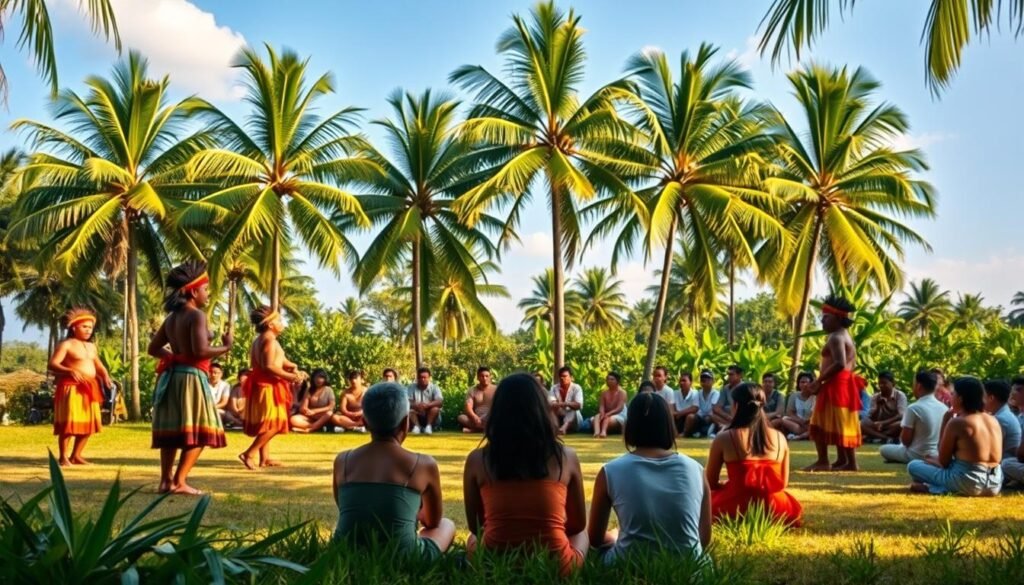
Indigenous Rituals and Oral Traditions
Performance in pre-colonial times was a communal activity. It often involved the babaylan and catalonan, spiritual leaders who acted as intermediaries between the physical and spiritual worlds. Their rituals included mimicry of natural elements, storytelling, and expressions of spiritual ecstasy.
These practices were not just entertainment but also a way to preserve history and teach moral lessons. Oral traditions played a key role, passing down stories from one generation to the next. This blend of myth and ritual laid the foundation for the country’s cultural identity.
Myth, Mimesis, and Spectacle in Early Performances
Early performances were rich in spectacle, often incorporating elaborate costumes and symbolic gestures. Mimesis, or the imitation of nature and human actions, was a central element. These plays were not scripted but improvised, allowing for creativity and spontaneity.
As noted by Juan de Plasencia in 1590, these ritualistic events were deeply symbolic. They reflected the community’s beliefs and values, blending myth with reality. This interconnection between myth, ritual, and spectacle set the tone for historical storytelling in the Philippines.
Spanish Colonial Influence on Theater Forms
The Spanish colonial era brought dramatic changes to local performance traditions. European dramatic forms were introduced, blending with indigenous practices to create a unique cultural identity. This fusion reshaped the way stories were told and performed, leaving a lasting impact on the region’s artistic history.
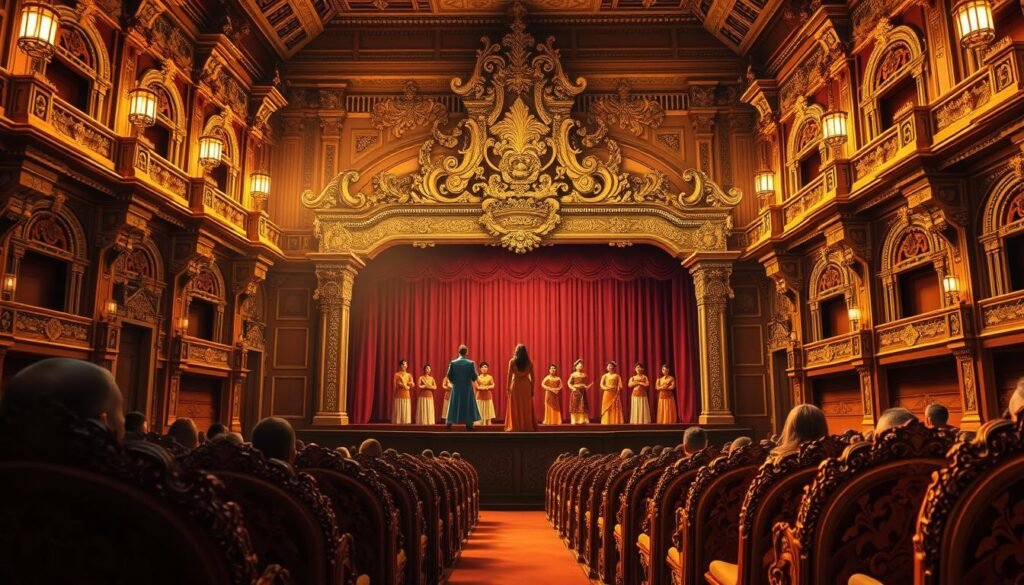
Zarzuelas, Comedias, and the Moro-Moro Tradition
Spanish colonizers introduced zarzuelas and comedias, which became popular among local audiences. These forms often featured religious narratives, serving as tools for moral teaching and religious conversion. The Moro-Moro tradition emerged as a distinct blend of European and local elements, showcasing the interplay between different cultural influences.
Actors from various groups adapted to these new forms, negotiating their identities while performing. The Moriones Festival in Marinduque, for example, reenacts the story of Longinus, blending ritual and performance. This tradition highlights how theater became a medium for cultural assimilation and storytelling.
The Role of Religious Conversion and Pedagogical Drama
Religious plays played a crucial role in spreading Christianity during the colonial period. These performances were not just entertainment but also a way to educate and inspire. The siete palabras presentation on Good Friday, for instance, depicted Christ’s death through ritualistic drama, leaving a profound impact on audiences.
Pedagogical drama became a cornerstone of colonial-era theater, embedding moral lessons in every performance. This approach ensured that theater was not only a reflection of life but also a tool for shaping it. The fusion of European and local traditions created a rich artistic legacy that continues to inspire modern productions.
Historic Evolution: Merging Indigenous and Colonial Traditions
The fusion of indigenous rituals and colonial theater forms marked a pivotal moment in the cultural evolution of the Philippines. This blending created a unique artistic identity, where local practices met European influences. The result was a rich tapestry of storytelling that continues to inspire modern productions.
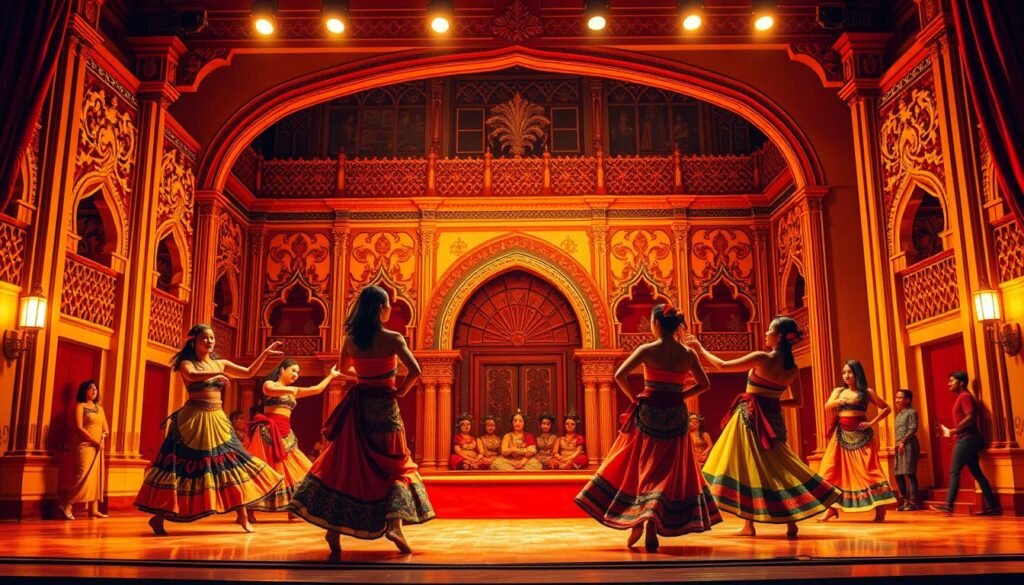
Blending Rituals with Western-Introduced Theater Forms
Local persons played a crucial role in reinterpreting European plays. They infused these productions with distinctly Filipino narratives, ensuring that the story resonated with local audiences. This creative adaptation allowed for a seamless blend of indigenous rituals and imported dramatic elements.
Production teams worked tirelessly to stage shows that celebrated both cultures. Their efforts highlighted the ang spirit, a term that embodies the resilience and creativity of the local community. This spirit became the driving force behind the evolution of theater in the region.
The narrative structure of performances also evolved. Indigenous rituals, once rooted in spiritual practices, found new life in theatrical productions. These shows became a medium for cultural expression, bridging the gap between tradition and innovation.
| Element | Indigenous Influence | Colonial Influence |
|---|---|---|
| Storytelling | Oral traditions and myths | Scripted plays and religious narratives |
| Performance Style | Ritualistic and symbolic | Structured and dramatic |
| Cultural Impact | Preservation of local identity | Integration of Christian values |
This cultural synthesis laid the foundation for modern stage practices. It showcased the ability of local artists to adapt and innovate, creating a legacy that continues to shape the performing arts today.
Modern Filipino Theater: Legacy and Contemporary Influence
Modern stage productions continue to reflect the deep cultural fusion of past and present. The influence of Spanish traditions remains evident in today’s artistic expressions. From restagings of classic works to innovative new creations, the power of storytelling continues to evolve.
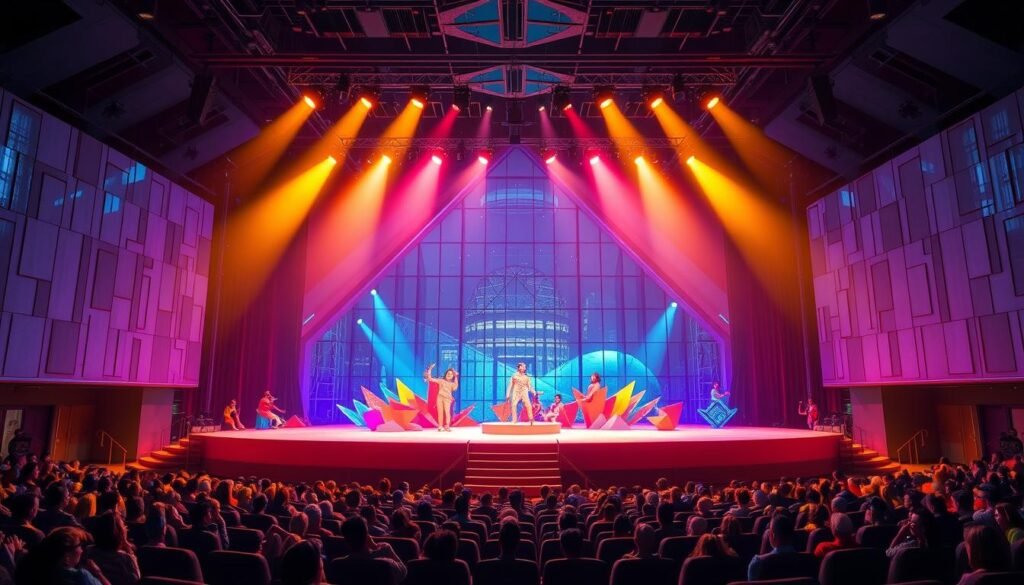
Legacy of Spanish Influence in Today’s Productions
Many contemporary works draw inspiration from colonial-era plays. The zarzuela and moro-moro traditions, for example, are often reimagined for modern audiences. These productions honor the past while exploring new themes and techniques.
Notable companies like PETA and Tanghalang Pilipino have played a key role in preserving this legacy. Their productions blend historical narratives with innovative staging, creating a unique artistic way of storytelling.
Contemporary Revivals and Experimentation on Stage
Events like the Virgin Labfest showcase the vibrant future of stage arts. This annual festival highlights original and experimental works, blending tradition with modernity. It’s a testament to the creativity and resilience of local artists.
Day-to-day productions often incorporate advanced lighting and sound design. These elements enhance the audience’s experience while maintaining reverence for traditional forms. The result is a dynamic and engaging day of performance.
Artist Perspectives on Tradition and Innovation
Artists today navigate the delicate balance between honoring the past and embracing the future. For many, it’s like blending an age-old song with modern beats. This approach ensures that cultural heritage remains relevant in a rapidly changing world.
Collaboration is key to this process. The collective power of production teams allows for innovative interpretations of classic works. Together, they create performances that resonate with audiences of all ages.
| Aspect | Traditional Influence | Modern Innovation |
|---|---|---|
| Storytelling | Religious narratives | Contemporary themes |
| Staging | Simple sets | Advanced lighting and sound |
| Audience Engagement | Community-focused | Global appeal |
This blend of old and new ensures that stage arts continue to thrive. It’s a testament to the enduring way in which culture evolves, inspiring both artists and audiences alike.
Postcolonial Perspectives and National Identity in Philippine Theater
Postcolonial perspectives have reshaped the way national identity is portrayed in Philippine theater. Scholars and critics have used varied lenses to assess the challenges of authenticity in a culture deeply influenced by colonial histories. This section explores how theater has become a space for critical reflection and redefinition of identity.
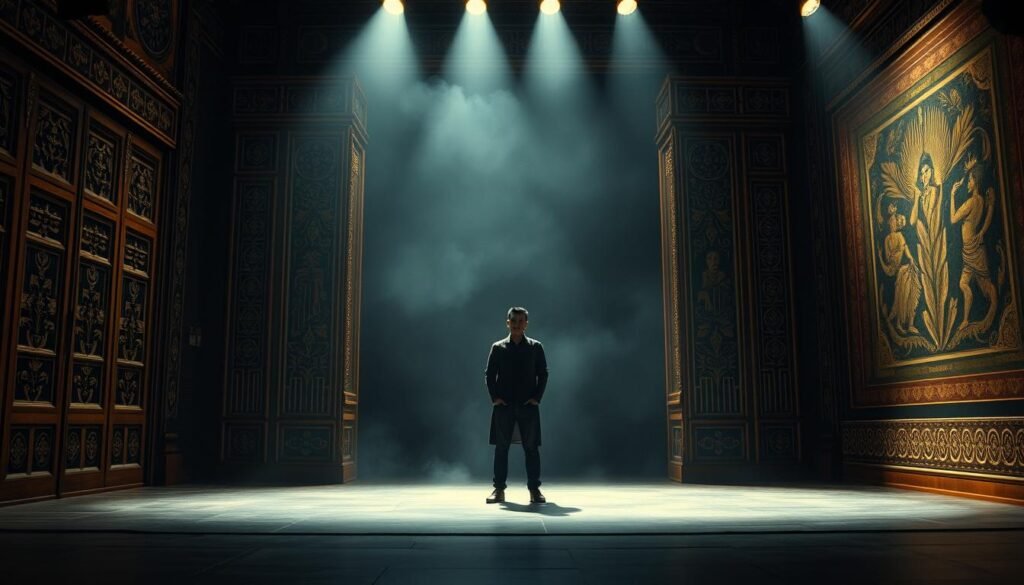
Navigating Authenticity in a Postcolonial Context
One of the key debates in postcolonial theater revolves around authenticity. How can playwrights and practitioners represent national identity without being overshadowed by colonial legacies? This question has sparked numerous scholarly discussions, as highlighted in this article.
As one critic noted,
“The struggle for authenticity is not just about rejecting colonial influences but also about embracing the hybrid nature of our cultural identity.”
This perspective underscores the complexity of creating theater that resonates with both historical and modern audiences.
Debates on Individual versus Group Identity
Another critical issue is the tension between individual and group identity. In a postcolonial context, theater often serves as a platform to explore these conflicts. Playwrights negotiate between personal narratives and collective experiences, reflecting the broader societal dynamics.
For instance, the zarzuela tradition, which blends European and local elements, has been reinterpreted to address contemporary issues. This evolution demonstrates how theater can adapt while preserving its cultural roots. As discussed in this analysis, such adaptations highlight the fluidity of national identity.
| Aspect | Colonial Influence | Postcolonial Adaptation |
|---|---|---|
| Storytelling | Religious narratives | Contemporary themes |
| Identity Focus | Group identity | Individual and group dynamics |
| Cultural Impact | Christian values | Hybrid cultural expressions |
This table illustrates the shift from colonial to postcolonial theater, emphasizing the ongoing negotiation of identity and tradition. Postcolonial theater remains a dynamic arena where historical narratives and modern cultural expressions coexist, shaping the future of Philippine artistic expression.
Performance, Production, and Technical Mastery in Stagecraft
Technical mastery in stagecraft has become a defining feature of modern productions. The seamless integration of innovative direction, lighting, and set design has transformed the way stories are told on stage. These advancements have elevated productions to a level of art that resonates deeply with audiences.
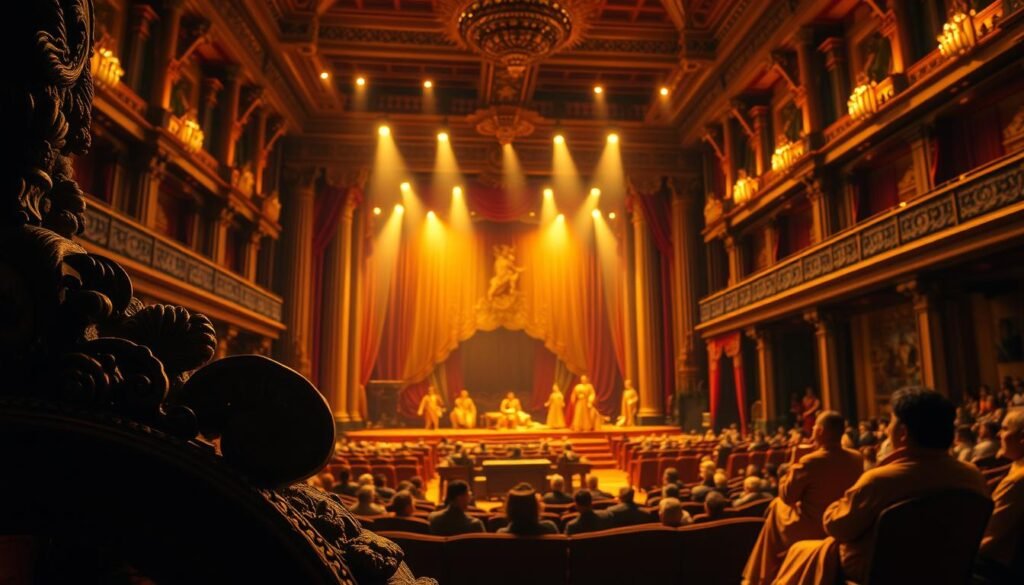
One of the most significant changes in recent years is the use of advanced lighting techniques. These methods create immersive environments that enhance the narrative and emotional impact of performances. For example, dynamic lighting can shift the mood of a scene instantly, drawing the audience deeper into the story.
Innovative Direction, Lighting, and Set Design
Directors and designers are pushing boundaries to create visually stunning productions. Set designs now often incorporate multi-dimensional elements, allowing for seamless scene transitions. This approach not only enhances the storytelling but also provides a cinematic experience reminiscent of film.
Collaboration is key to these innovations. Production teams work closely to ensure that every element, from lighting to set design, aligns with the director’s vision. This teamwork ensures that the final product is cohesive and impactful.
Collaborative Efforts in Choreography and Musical Scoring
Choreography and musical scoring play a crucial role in modern stagecraft. These elements add layers of emotion and depth to performances, making them more engaging for the audience. Choreographers and composers often work hand-in-hand with directors to create a unified artistic vision.
For instance, in productions like One More Chance the Musical, the choreography and music are intricately woven into the narrative. This integration ensures that every movement and note enhances the story, creating a memorable experience for viewers.
“The collaborative process in stagecraft is what transforms a good production into a great one. It’s the synergy of creative minds that brings the art to life.”
| Element | Traditional Approach | Modern Innovation |
|---|---|---|
| Lighting | Static and functional | Dynamic and immersive |
| Set Design | Flat and two-dimensional | Multi-dimensional and interactive |
| Choreography | Simple and repetitive | Complex and narrative-driven |
These advancements highlight the ongoing evolution of stagecraft. By addressing issues like resource allocation and technical experimentation, productions continue to push the boundaries of what is possible. This change not only enhances the art form but also ensures its relevance in a rapidly evolving world.
For more insights into the evolution of stagecraft, explore this detailed analysis.
Cultural Impact: Community, Tradition, and Audience Engagement
The vibrant interplay of community and tradition has shaped the cultural landscape of performance arts in the Philippines. From the bustling streets of Manila to the rural towns, these productions serve as a bridge between the past and the present. They foster unity and inspire collective engagement, making them a vital part of the nation’s identity.
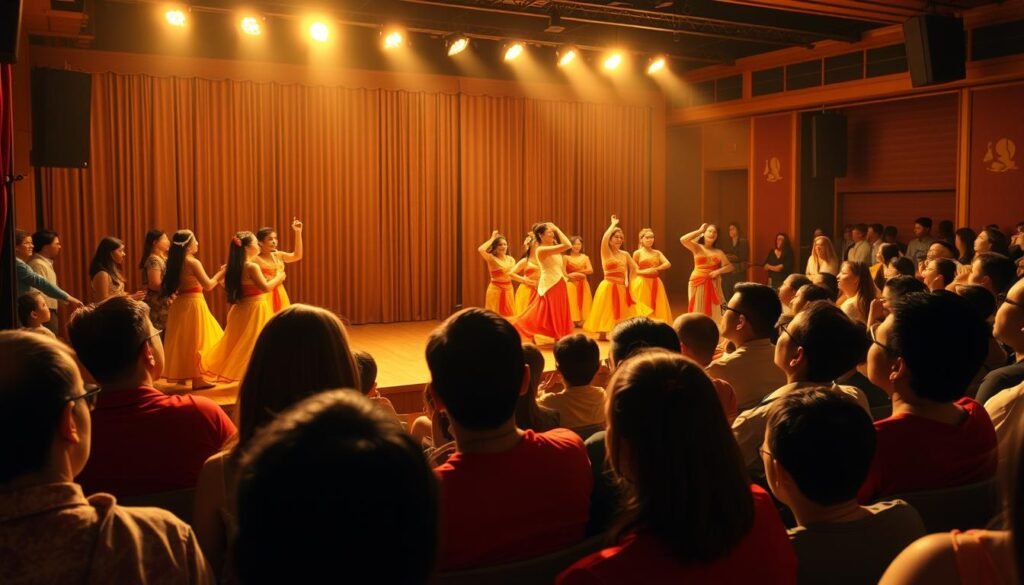
Community Unity and the Revival of Traditional Forms
Performance arts have long been a medium for bringing people together. Traditional forms like dance and drama have been revitalized, blending historical practices with modern storytelling. These adaptations resonate deeply with audiences, creating a sense of continuity and shared heritage.
In Manila, productions often highlight distinctly Filipino elements, celebrating the country’s rich cultural tapestry. These performances not only entertain but also educate, fostering a deeper appreciation for local traditions. As noted by one critic,
“Theater is more than art; it’s a reflection of our collective soul.”
The global stage has also embraced Filipino performance arts. Productions showcased around the world highlight the country’s unique blend of tradition and innovation. This international recognition underscores the universal appeal of these cultural expressions.
To learn more about the role of community engagement in cultural heritage, explore this detailed analysis.
Ultimately, performance arts in the Philippines serve as a state of cultural continuity. They nurture community heritage while inspiring ongoing dialogue. This reciprocal relationship between performers and audiences ensures that these traditions remain vibrant and relevant.
Conclusion
The journey of performance arts in the Philippines reveals a rich tapestry of cultural evolution. Spanish colonization laid a foundation that blended indigenous rituals with colonial influences, shaping a unique artistic character. This fusion highlights the resilience and adaptability of local traditions, which continue to inspire modern productions.
Today, the influence of these historical elements remains evident. Artists skillfully balance tradition and innovation, creating works that resonate with audiences. The technical mastery in stagecraft, from lighting to set design, has elevated performances to new heights, ensuring their relevance in contemporary culture.
Individual and group contributions have played a pivotal role in cultivating an authentic national identity. This dynamic dialogue between history, culture, and artistic innovation keeps the art form alive and evolving. For more insights into this cultural journey, explore this detailed analysis.
As the art form continues to thrive, it invites further reflection on its past and future. The right blend of tradition and modernity ensures that these performances remain a vital part of the cultural landscape, inspiring both artists and audiences alike.
FAQ
What are the origins of theater in the Philippines?
The roots trace back to pre-colonial times, where indigenous rituals and oral traditions laid the foundation for early performances. These often included myths, mimesis, and spectacle.
How did Spanish colonization shape theater forms?
Spanish influence introduced zarzuelas, comedias, and the Moro-Moro tradition. Religious conversion and pedagogical drama also played significant roles in shaping these art forms.
How did indigenous and colonial traditions merge in theater?
Over time, local rituals blended with Western-introduced forms, creating a unique fusion that reflected both cultural heritage and colonial impact.
What is the legacy of Spanish influence in modern productions?
Today’s performances often reflect this legacy through themes, styles, and structures, while also embracing contemporary revivals and experimentation.
How does postcolonial identity influence theater?
Artists navigate authenticity by exploring individual and group identity, often sparking debates on how to represent national culture in a postcolonial context.
What role does technical mastery play in stagecraft?
Innovative direction, lighting, set design, and collaborative efforts in choreography and musical scoring are crucial for creating impactful productions.
How does theater engage communities?
It fosters unity by reviving traditional forms and encouraging audience participation, strengthening cultural ties and preserving heritage.
Source Links
- Contemporary theatre in the Philippines
- In Focus: Philippine Theater in English – National Commission for Culture and the Arts
- The Literary Forms in Philippine Literature – National Commission for Culture and the Arts
- History of Philippine Cinema – National Commission for Culture and the Arts
- phr journal2010.indd
- WATCH: 7 Forms of Philippine Theater During the Spanish Colonial Period
- The Evolution of Philippine Theatre
- Culture of the Philippines
- EMBODIED INDIGENEITY: TRANSLATING TRADITION FOR THE PHILIPPINE CONTEMPORARY DANCE STAGE
- The Manila Chinese Cemetery: A Repository of Tsinoy Culture and Ide…
- WATCH: 8 Philippine National Artists for Theater
- The Other " Other " Cinema: National and Cultural Identity in Filipino Alternative Films
- July 4, 1946: The Philippines Gained Independence from the United States | The National WWII Museum | New Orleans
- From Recognition to Integration: Indigenous Autonomy, State Authority, and National Identity in the Philippines | American Political Science Review | Cambridge Core
- Technical Production for the Performing Arts Industry
- Theatre and Music in Manila and the Asia Pacific, 1869-1946
- 2024: A full theatrical calendar – BusinessWorld Online
- PETA – Philippine Educational Theater Association
- Section 6: Overall Impact of Technology on the Arts
- The best Filipino theater of 2023
- In Focus: Seditious and Subversive: Theater of War – National Commission for Culture and the Arts

